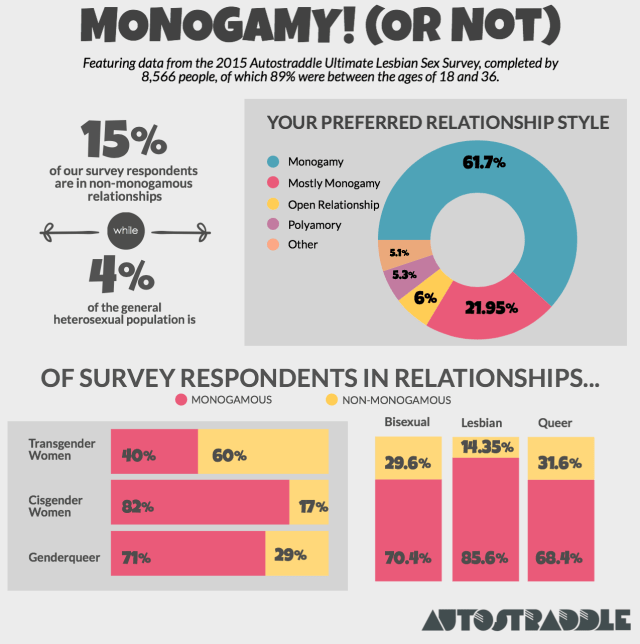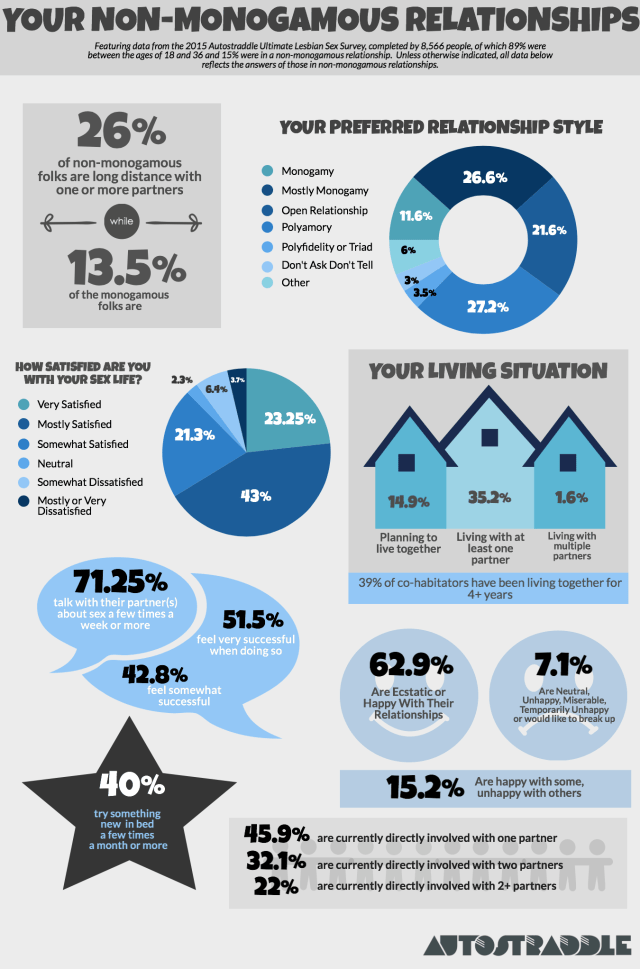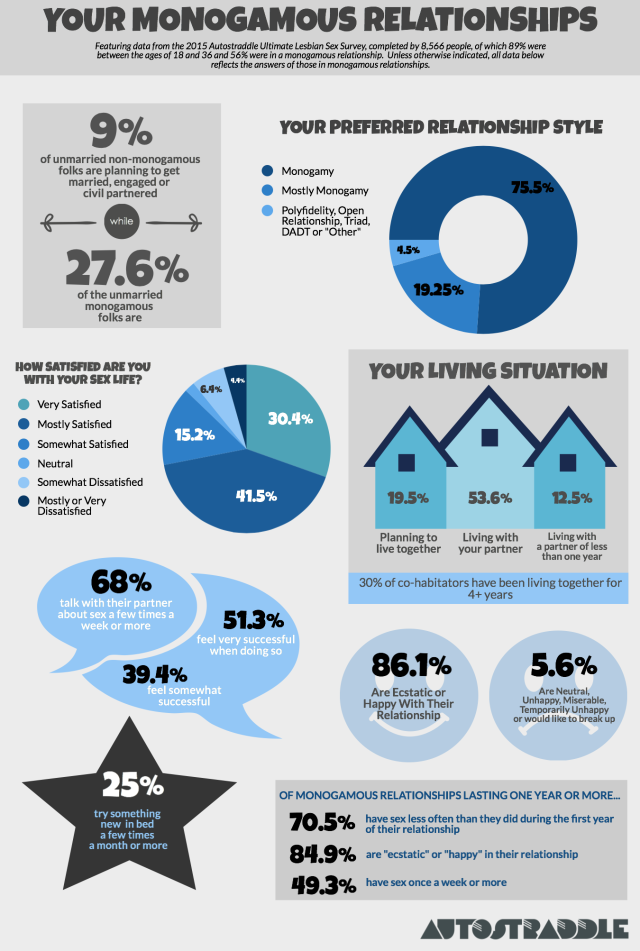In February 2015, Autostraddle launched The Ultimate Lesbian Sex Survey, open to all “lady-types who sleep with lady-types.” We garnered over 8,566 complete responses (89% of which were from people between the ages of 18 and 36) and now we’re sharing the results with you, bit by bit. Previously: How Often Do Queer Women Have Sex?, 100 Gayest Places You’ve Had Sex, The Masturbation Habits of Queer Women, 50 Really Fascinating Things You Wanted Us To Know About How You Have Sex, 26 Bits of Solid Sex Advice, 41 Feelings You Have About Scissoring, Here Are Your Very Queer Underwear-Wearing Habits, When It Comes To Orgasms, Lesbians Are Nailing It, The 100 Most Ambitious Places You’ve Had Sex and When Did You Do It For The First Time and How Many People Have You Done It With, Huh?.
Hello, sex maniacs! Today we’re gonna talk about the differences and similarities between the sex lives of those in non-monogamous relationships vs. monogamous relationships as well as those who prefer different relationship styles.
The internet has served to make people more aware of and empowered by non-monogamy than ever before. Dr. Elisabeth Sheff, author of The Polyamorists Next Door, writes on her website that research has shown that “sexual styles such as polyamory have increased with the advent of Internet technology, which facilitates communication between geographically disparate people seeking support for alternative relationships.” She concludes, “in recent years, the Internet has proved an especially important site for community building among marginalized populations… The impact of the worldwide web on the polyamorous community would be difficult to overstate.”
This becomes doubly true for non-monogamous queers, and perhaps three times truer for transgender non-monogamous queers — so many layers of “alternative relationships” suddenly open for immediate discussion! And although the media is completely obsessed with gay male non-monogamy, there’s not a lot out there about non-monogamy rates among queer women. So, let’s talk about it now!
We asked survey-takers for their current relationship status. The options were “in a monogamous relationship,” “in a non-monogamous relationship of any form” and “not in a relationship.” That came out like this:
- 55.97% are in a monogamous relationship
- 29.17% are not in a relationship
- 14.86% are in a non-monogamous relationship of any form
We also asked all survey-takers for their preferred relationship style, which broke down into more specific categories:
- 61.7% chose Monogamy: An exclusive relationship between two people.
- .39% chose Triad: A closed relationship that involves three people instead of two.
- .58% chose Polyfidelity: A closed relationship with sexual and emotional fidelity required of a group that is larger than two.
- 5.3% chose Polyamory: Participants have multiple romantic and sexual partners, ideally with everybody involved being aware of and consenting to the arrangement.
- 6% chose Open Relationship: Two humans in a committed relationship decide that they’re allowed to hook up with other people, together or separately.
- 1.44% chose Don’t Ask, Don’t Tell: Partners are free to do whatever they want with whomever they want as long as it never becomes known to their other partner, either via direct disclosure or other obvious behavior or relationship changes. This is tricky.
The other category, Mostly Monogamy (chosen by 22% of survey-takers) means many different things to many different people. For some people, this just means not cutting off the possibility of involving other partners (e.g., threesomes) or even kissing other people with my girlfriend present and involved. For some people, it means other things, and maybe you’ll tell us in the comments! Regardless, it was a popular choice for both monogamous and non-monogamous folks on our survey, but we didn’t want to draw any conclusions from that without knowing your own definitions.
Okay, so, first let’s look at some of the demographic differences between people in monogamous and non-monogamous relationships.

There’s also lot of kink happening in non-monogamous relationships: 74.5% of those in non-monogamous relationships are interested in kink, compared to 52% of those in monogamous relationships. Only 9% of the non-monogamous folks aren’t interested in kink regardless of their partner’s interest, compared to 20.6% of the monogamous.
Now let’s look at these groups individually.
Non-monogamous Relationships
15% of our respondents — 1,273 people total — were in non-monogamous relationships. The infographic below contains a wealth of information we gathered from your surveys:

What’s Going On With The Monogamous People In Non-monogamous Relationships?
I was interested in that 11.6% of those in non-monogamous relationships who picked “monogamy” as their preferred relationship style. We get a lot of advice questions from women whose long-term girlfriends want to open up the relationship but they’re resistant to it (e.g., You Need Help: Your Girlfriend Wants to Date Other People and It’s Breaking Your Heart), which is one potential explanation for this discrepancy. It’s also possible that these are women who’ve never done non-monogamy before, but are trying it out with a new relationship. So, I did some digging.
Looking at just that group — current non-monogamous relationshippers who prefer monogamy, who I’ll refer to as the Non-Monog Monogs, or NMMs, going forward — the happiness pie does change quite a bit. 10.9% are “ecstatic” and 25.8% are “happy” in their relationship, compared to 26.3% and 36.6%, respectively, of the whole non-monogamous group. The most popular selection for the NMMs was “kinda happy,” which topped out at 27.9%, compared to 14.7% of the entire NM group who defined themselves that way. “Happy with some, unhappy with others” is pretty similar (15.2% vs 16.3%), but only 3.4% of the whole NM group felt “neutral,” opposed to 10.9% of the NMMs. Only six people in the entire NM group picked “would like to break up” — and five of them were NMMs.
Are they just trying something new with a new partner? Quite possibly, yes! Most of these relationships are fairly new or casual. Nearly 52% reported being with their primary partner for less than six months, with 74.8% reporting relationship lengths of under a year, and the overwhelming majority reported length of involvement with any additional partners at under a year, mostly under six months. Only 11% of the NMMs said they lived with a partner, compared to 35% of the entire NM group. 66% of the NMMs described their relationship as “dating casually.”
Are they reluctantly exploring non-monogamy due to distance? Although that’s definitely the case with nearly one-quarter of this group, it’s worth noting that this group is not more likely to be in a long-distance relationship than those preferring other relationship styles. In fact, 24.9% of those who prefer polyamory are in LDRs with at least one partner and 11.3% with multiple partners, whereas 21.8% of the NMMs are in LDRs with one partner and none are in LDRs with multiple partners.
So, what’s the answer? The open-ended answers from NMMs to “if you could change anything about your sex life, what would it be?” were very revealing, and enabled me to split this group into four sub-groups based on the four types of answers I saw pop up most frequently and aforementioned stats.
1. I want more sex: People trying non-monogamy to see if it brings more sex into their lives due to having a higher sex drive than their primary partner or not having enough opportunities to have sex with their primary partner. For example:
- “How I would improve my sex life would be for my fiance to feel sexy and want to have sex with me more than once a month or less.”
- “I wish my partner had as high of a sex drive as mine or that I had an easier time having sex with people I’m not in love with (which I don’t want).”
- “That it would happen more often. Current partner doesn’t match my sex drive.”
2. I want my partner to live where I live: People trying non-monogamy because their partner lives too far away and they see each other too infrequently to meet their sexual needs.
- “My woman being in the same state.”
- “I would be able to physically be with her more often (not long distance), there would be more exploration, and more kink.”
- “To live closer to my partner/have sex more often (and therefore feel closer to her emotionally)”
3. I want more confidence in bed: These answers were brief — usually just “more confidence” — and frequent. But I have no theories about this group, only the awareness that they exist.
4. I’d rather be in a monogamous relationship and/or I’d like to meet someone I’d want to be monogamous with: People who are reluctantly in a non-monogamous situation at a partner’s request or are willingly in one ’cause they’re not interested in getting serious with a present partner. Examples:
- “I’d like to be in a monogamous relationship.”
- “My partner is poly with one other partner and I’m not sure I really like it.”
- “I would be having sex with fewer people.”
- “Because my partner has another partner she lives with, we lack opportunities.”
- “Having one partner.”
- “More sex in a monogamous relationship.”
- “Maybe… I should go find a sexual partner I actually like.”
- “I would like to be in a long term relationship with a partner, not just a friend-with-benefits.”
- “Would be in a committed relationship with someone I’m in love with”
- “I miss being with a partner that I’m in love with”
- “Ideally I’d have one life-long monogamous partner that I have sex with at least once a day.”
And Now For The Monogamous…

What’s Going On With The Non-Monogamous People In Monogamous Relationships?
This particular sub-group is pretty interesting because it’s revealing in terms of how a certain (potential) conflict that arises between couples looks on one side. We rarely have a chance to look at hard data about relationship issues, you know?
So, Non-monogamous people in Monogamous Relationships are a smaller percentage of the whole than we’ve got in the reverse instance, but it’s a larger number of people, period, which means there’s still statistically significant morsels to uncover. I’ll refer to this group as the Monog Non-nonogs, or MNMs, going forward, but here’s how preferences break down within that group:
- “Don’t ask don’t tell” – 18.8%
- Open relationship – 32.4%
- Triad – 2%
- Polyfidelity – 3.6%
- Polyamory – 14%
- Other – 29.2%
“Other” ran the gamut, but included a lot of: “I don’t know,” “I have no preference,” “I’m open to whatever my partner is into” and “I’m interested in exploring open or poly situations.” There were also combinations of styles, like “monogamy with threesomes every once in a while.” Several people said they were doing monogamy for their partners’ sake — which seems to be a more amicable relationship than the reverse, perhaps due to monogamy being the cultural norm, or the idea of opening it up coming later in a long-term relationship.
Only 19.2% of these couples were less than 6 months old, and 14% less than a year, which is pretty consistent with the whole group. 62.9% lived together and 30.4% were married, engaged or civil partnered. Only 7.6% qualified their relationship as “dating casually.” This is a huge contrast to what we found with NMMs.
But only 72.8% are “happy” or “ecstatic” in their relationship, compared to 86.1% of the whole monogamous group and 89% of monogamy-preferrers in monogamous relationships. 2% of the whole group was unhappy or wanted out of their relationships, compared to almost 5% of the MNMs. 14% of the MNMs were kinda happy, compared to 8.2% of the whole monogamous group. 58% were mostly or very satisfied with their present sex life — but that’s compared to 71.9% of the whole group and 74.2% of monogamy preferrers.
The most dissatisfied group of humans were those in monogamous relationships who prefer “Don’t Ask Don’t Tell.” That seems like it probably has an obvious explanation.
What would they change about their sex lives if they could? MORE. More sex or more people to have sex with. Some answers included:
- “More kink, introducing non-monogamy, finding a top”
- “More confidence from my side, open/poly relationship with my partner, maybe trying something with a man again sometime? and more kink.”
- “I would like to be more polyamorous.”
- “My current sexual partner. Finding the right partner/butch. Bringing more kink into the bedroom. Trying multiple sexual partners (poly or open relationship)”
- “Receiving oral sex from my current partner, get to sleep with other people”
Here’s what seems to be happening: for perhaps a slim majority, but still a majority, of these women, non-monogamy isn’t necessarily a relationship style they prefer but are presently sacrificing for their partner’s sake, but rather something they’re considering because their present relationship is lacking sexually: in frequency, in kinkiness, in acts performed, in the gender identities of the humans involved or in any other way.
Regardless, judging by the length and seriousness of the relationships, people definitely feel more comfortable sticking with monogamy despite non-monogamous leanings than they do with the reverse situation. This could change as cultural norms do, or perhaps has always been so and always will be.
Let’s Talk About Not Talking About It
Folks who indicated a preference for Don’t Ask Don’t Tell relationships stood out statistically from the other groups in many ways, which is very interesting! Here are some of those ways:
- 51% want sex once a day or more, compared to 35.6% of everybody else, 35.9% of monogamy-preferrers and 38.5% of poly-preferrers.
- 46.3% say they never use protection when having sex, which is significantly lower than the amount of monogamy-preferrers who never use protection (70.4%) and significantly higher than other non-monogamy-style-preferrers, especially poly-preferrers (only 22.3% of poly-preferrers confessed to never using protection).
- 22.8% of DADT-preferrers have never been tested for STIs, a number slightly lower than the monogamy-preferrers (25.9%) but much higher than preferrers of all other relationship styles (Only 8.75% of poly folks have never been tested).
- DADT-preferrers were much more likely to be in a monogamous relationship than others who preferred non-monogamy — whereas 7.7% of poly-prefferers are in monogamous relationships and 15.8% of open relationship preferrers are, 38.2% of DADT-prefferers are presently in a monogamous situation.
- 40.4% of DADT-preferrers in monogamous relationships were in relationships lasting 3+ years, compared to 30.2% of everybody else.
On page two, we’ll look at some popular beliefs about non-monogamy and how these ideas hold up in the face of daunting data.
Pages: 1 2See entire article on one page

No more words, just…
Buggerit, that was meant to quote
“research has found that “regardless of the target’s sexual orientation, individuals who engaged in consensual non-monogamy were viewed more negatively than individuals who engaged in monogamy on all seven dimensions.” “
Whoever ran the statistical analysis on the STI testing and thought to remove the confounder of acquiring STIs gets 100 statistics sparklepoints and a grateful round of applause from the scientific peanut gallery.
THANK YOU FOR THE SPARKLEPOINTS
Definitely have, in the past, been in the situation of wanting to date someone who’s poly when I’m monogamous. Yup, it’s pretty bad!
I’d be so interested to see that quadrupled likelihood of non-monogamy in trans women broken down — what are trans women’s preferred relationship styles? I am non-monogamous, but very aware of my lack of options if I were to seek a monogamous partner (or even a poly “primary” partner, not that I like that expression) as a trans woman.
Yes definitely. I’ve done some thinking on this, but haven’t entirely worked it out.
My first thought was on the tendency for trans women to be relegated to a secondary relationship position and to be the first dumped if need be. But I can’t imagine that being the case for everyone.
Secondly, given that significantly more trans women identify as non-monosexual than their cis counterparts, combined with this survey showing that non-monosexuals have a higher tendency for non-monogamous, might speak for more trans women to be non-monogamous.
Or there could be other possible reasons I haven’t come up with. I’m trans and non-monogamous and most other trans people I know are as well.
Thanks for this article, Riese! I am monogamous, and have only had sex with the woman who is now my wife. She on the other hand is polyamarous. She transitioned before we met, but had grs surgery after we got married. Since we’ve been together and I assured her I was okay with it, she’s been with two other people, one specifically for kink as I’m very vanilla. Currently she isn’t interested in seeing anyone else. It isn’t something that is talked about much, or at least it isn’t something I talk about much (I know my wife and her friends talk more about it). So all of this is to say that I found the article very interesting!
Hm it’s really interesting atatistic! It’s interesting to know details about monogamous relationships! As for me, I can say that I’m in non-monogamous relationships! I and my girlfriend are dating with other people! We met them online on dating services( tinder, okcupid, kovla ) And I don’t think that it’s wrong! Our relationships became only stronger!
This is a great infographic. You don’t see many articles about non monogamy because some call it a taboo subject. In fact I only read two articles about it. This one and another on this site https://www.fapshows.com/blog/monogamy-it-s-not-for-everyone which in my opinion means that people are starting to embrace these things and accept them.